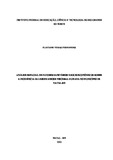Análise espacial de fatores sanitários e socioeconômicos sobre a incidência da leishmaniose visceral humana no Município de Natal-RN

Visualizar/
Data
2022-04-29Autor
Fernandes, Flaviane Veras
http://lattes.cnpq.br/5871055249419187
Metadado
Mostrar registro completoResumo
Human visceral leishmaniasis (LVH) began in Brazil around 1932, in the rural area of the northeastern semi-arid region. The first urban outbreaks in Brazil were recorded in the late 1980s and early 1990s, due to migratory processes from rural to urban areas, the disorderly growth of cities, the occupation of forested areas, inadequate infrastructure sanitation, the vector's ability to adapt to peri-urban environments and HIV-leishmania co-infection. The LVH urbanization process has been growing in the greater Natal area, and may be associated with some factors of disordered land use and occupation, especially in peripheral areas. This is a study whose objective is to analyze the spatial regressions between the incidence rates of the number of cases of HVL associated with socioeconomic and environmental variables and their spatial distribution in the city of Natal. The spatial analysis is from 2010 to 2019, considering the administrative areas of the municipality. In particular, quantitative aspects related to sanitary structures, urban paving, income and education of the resident population were spatially rendered in order to verify the spatial correlations of these factors with the response variable. The techniques applied in this investigation were based on spatial geostatistics tools through the univariate and multivariate regression model using the GeoDa software. The results of the spatial analyzes were visualized through thematic maps that can be inserted in an environment of free access, for continuous updating of the data, and that can serve as a tool in the aid of measures of prevention and control of HVL.



